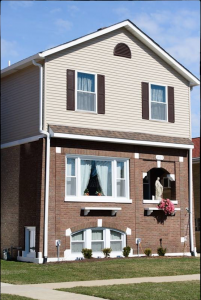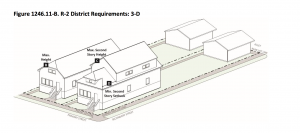Berwyn bungalow lovers want to #Stopthepop
By Jean Lotus Staff Reporter — August 15, 2017
In Berwyn, these rehabbing projects are prompting critics to label the homes “pop tops” or “trailers.” The second-floor additions sometimes have clapboard or shingle siding that clashes with the bricks below
Architectural purists call them “pop tops” or “trailers.” Developers call them “deluxe full second-story additions.”
A reminder of the recession and housing rehabbing frenzy, many vintage streetscapes of Chicago and pre-war suburbs have a house or two that has been remodeled with a complete tear-off of the second floor.
These new additions sometimes have clapboard or shingle siding that clashes with the bricks below. Many have a “structurally overwhelming” design, say members of the Historic Chicago Bungalow Association.
In Berwyn, called the “City of Homes,” more than 1,300 Chicago-style bungalows are clustered in a bungalow district recognized in 2015 by the National Registry of Historic Places. There are more than 40 different varieties of bungalows with varying design elements such as art glass, interior woodworking and brickwork.
“People took such great pride in the buildings in Berwyn,” said historian Douglas Deuchler, author of “Berwyn (Images of America: Illinois),” published in 2005. “In Oak Park, they took out the art glass and removed the woodwork and the tile roofs to follow the fads of the era,” he said. “Berwyn is like an open air museum of these 1920s homes.”
Berwyn’s proposed new zoning plan will be presented in a public hearing by the Chicago Metropolitan Agency for Planning on Aug. 17 in City Hall. CMAP has been working for several years to unify a mishmash of city ordinances.
The new zoning code is a point of ideological struggle in Berwyn between preservationists and flippers. Preservationists believe home values in Berwyn will rise because of the city’s unique housing stock. Developers believe that modern families want new-construction amenities, which will sell houses and get them back onto the tax rolls at a higher assessed rate.
The Historic Chicago Bungalow Association has started a “#StopthePop” campaign, urging developers to build additions that fit in with the other homes on a block.
“‘Pop tops,’ destroy the architectural/aesthetic value of homes and streetscapes, as well as neighbors’ property values,” the group’s website says.
Berwyn already has strict local ordinances for second-story dormers, including rules requiring a six-foot setback from the front of the home, preserving the original dormer roofline and not exceeding the original height of the building.

Berwyn’s new Chicago Metropolitan Agency for Planning (CMAP) zoning plan includes special setbacks for bungalow dormers that make them less obtrusive. (Courtesy of CMAP)
But these rules were seemingly not enforced by the building department as homes were foreclosed during the housing comeback and developers snapped up bargains. Crain’s Chicago Business reported Berwyn was among the top 20 most profitable U.S. towns for flippers in 2014, with returns of more than 120 percent.
“Pop top” additions sprouted on some of Berwyn’s bungalows, and flippers made a killing converting modest two-bedroom houses worth around $150,000 into five-bedroom homes selling for $350,000 or more.
Some of the developers of these properties had ties to local politicians, including Mayor Robert Lovero, a real estate attorney.
An example is a converted bungalow in the 6800 block of 30th Street.
Developer Mark Fiebig, of Darien, bought the 1,100-square-foot property in October 2014, for $100,000. Fiebig served as Berwyn building director for about a year in 2005. He is known to be close to Lovero, with whom he once shared ownership of a thoroughbred bay mare racehorse called Kissin’ Beauty.
Fiebig rehabbed the property with a second-story tear-off into a 2,200-square-foot five-bedroom, four-bath luxury home. “Burr Ridge has come to Berwyn!” exclaimed the real estate listing. The house sold for $335,000 in October 2016. The “pop top” addition did not follow city codes for a setback, height or roofline.
Fiebig declined to comment about the specific house. But in a 2016 interview, he said that he hasn’t lived in town for a decade and his relationship with Lovero or anyone else had no influence on his business.
“I build in lots of communities, and if you take a look at any of my projects they are fabulous,” he said. “We rehab completely down to the studs with new electrical, plumbing, heating and cooling.”
The owner of the home declined to comment.
Another “pop top” conversion was a bungalow located on Berwyn’s crown-jewel boulevard, Riverside Drive. The 1½-story, 1,440-square-foot bungalow in the 6900 block was purchased for $140,000 in June of 2014 by UGX Property and Building Solutions, an offshoot company owned by Berwyn real estate investor Rich Neubauer, owner of Unlimited Graphix in Lockport.
Again, the “pop top” addition skirted city codes for a setback, height and roofline.
The Riverside Drive property was remodeled into a five-bedroom home advertised with a “stunning new second floor addition” that included a “luxurious Master Bedroom W/Master Bath Walk In Shower W/Multiple Body Jets, Double Sink!” It sold for $357,000 in November 2014.
Robert Lovero was listed as contact agent on the warranty deed for the property sold by UGX. Lovero was out of the country on vacation and unavailable for comment about the relationship. Neubauer did not immediately return calls for comment.
Even the city’s current building director, Chuck Lazzara, has gotten in on the flipping business. Under the auspices of Evolution Properties Group, Inc., a company registered to Lazzara, a one-story home in the 2500 block of Harvey purchased for $25,000 in 2013 was flipped and sold for $245,000 a year later. In 2014, Evolution Properties purchased a $95,000 foreclosure in the 6500 block of 25th Street through the Cook County Land Bank. After a gut renovation and installation of a “no expense spared chefs paradise” in the kitchen, the bungalow sold for $245,000 in February 2017. Lazzara did not return calls for comment.
The city ordinances for height, setbacks and rooflines were developed in 2005 in conjunction with a blue ribbon panel that worked together to set up a preservation ordinance, said Lori Thielen, former head of the Berwyn Historic Preservation Commission. “Bobby Lovero was on that panel with me,” she said. Thielen, a former antique shop owner who now lives in Florida, said the group worked with the Illinois Historic Preservation Agency.
“Call it narrowmindedness or the call of the dollar, but Berwyn is always fighting the developer,” Thielen said. “There are four Frank Lloyd Wright homes in Berwyn. They should be celebrating that stuff. Berwyn should recognize they can increase their property values by preservation.”
Members of the city’s growing preservationist community complain about the “pop tops” and want to make sure the city’s new zoning plan has teeth to enforce zoning codes.
“I’d like to see these protections on all the other magnificent home styles such as Tudors, Four-squares, prairie, Victorians, Queen Annes, cottages, and even mid-century modern, so they can be valued as historic homes,” said Matt Schademann, bungalow-owner and founder of the Preservation Berwyn group.
Preservationists blanketed parts of the city with fliers last week, calling out aldermen for allegedly supporting watered-down building codes.
“Political garbage” was how First Ward Ald. Scott Lennon characterized the fliers.
“I am unsure why I was specifically singled out,” he said in an email. In 2015, Lennon purchased a Berwyn bungalow updated with a new second-floor addition.
“We have been working on this updated zoning ordinance for the last 3 years,” Lennon wrote. “As well, the city has held public meetings and adjusted as needed after receiving feedback from residents, conducting research and reviewing other municipalities’ codes.”
CMAP Project Manager Jacob Seid said the organization incorporated recommendations from the #StopthePop campaign and local preservation voices to add special 15-foot setbacks in the Berwyn bungalow zones of the new plan.
“This is the first time that we have included bungalow addition standards in one of our zoning projects because these homes are such a unique and important part of the Berwyn’s character,” he wrote.
Deuchler said Berwyn’s housing stock is special, ironically, because the city’s 1920s building codes were so strict.
Immigrants, many from the Pilsen neighborhood in Chicago, bought Berwyn bungalows as their first step migrating out of the city chasing better jobs and seeking a piece of property.
“In the 1920s, whole blocks of bungalows went up at one time, within five or six years. There were thousands of these, and they were not fly-by-night construction. They’re all so well made,” he said. “Berwyn always had such strong building codes on things, you knew you were getting a great home, because everything was enforced,” Deuchler said. “They are still beautiful, 95 years later.”
Read the current issue of the Cook County Chronicle
Free subscription to the digital edition of the Cook County Chronicle
— Berwyn bungalow lovers want to #Stopthepop —



